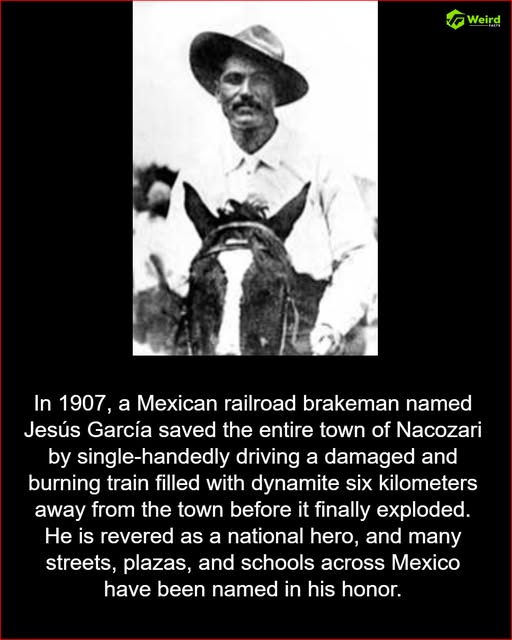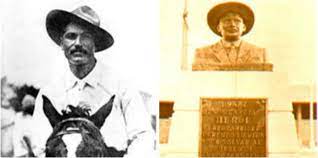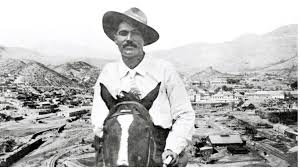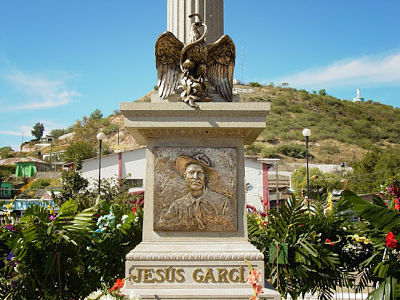Jesús García: The Hero of Nacozari Who Saved a Town at the Cost of His Life
- James Smith
- 0
- Posted on

García was the railroad brakeman for the train servicing the route between Nacozari, Sonora, and Douglas, Arizona. On November 7, 1907, the train stopped in Nacozari, and while he was resting, he noticed that some hay on the roof of a car carrying dynamite had caught fire. The fire was caused by a malfunction in the locomotive’s smokebox, which allowed sparks to escape from the smokestack. The wind carried these sparks toward the dynamite cars. Realizing the danger, García quickly drove the train in reverse at full speed, taking it six kilometers out of town before the dynamite exploded. His actions ultimately saved the residents of Nacozari, but sadly, he lost his life in the process.

On November 7, 1907, a young railroad brakeman named Jesús García performed an extraordinary act of bravery that would go down in Mexican history. His selfless actions saved an entire town from disaster, but they also cost him his life. Today, Jesús García is remembered as “El Héroe de Nacozari” — The Hero of Nacozari — a symbol of courage and sacrifice.
A Routine Day Turns Dangerous
García worked as a railroad brakeman on the route between Nacozari, Sonora, a bustling mining town in northern Mexico, and Douglas, Arizona, just across the U.S. border. On that fateful day in 1907, the train was making a stop in Nacozari to rest and refuel. The train carried various supplies, including several cars loaded with dynamite—a common cargo at the time for mining operations.
While resting near the train, García noticed something alarming: hay on the roof of one of the dynamite cars had caught fire. The blaze was sparked by a malfunction in the train’s locomotive smokebox, which allowed embers to escape from the smokestack. These burning fragments, carried by the wind, had landed on the dynamite-laden cars — a recipe for catastrophe.

A Race Against Time
Realizing the imminent danger, García didn’t hesitate. He quickly sprang into action, fully aware of the risk. Without waiting for orders or assistance, he climbed aboard the locomotive and drove the train in reverse at full speed, attempting to move the train—and the burning dynamite—as far away from the town as possible.
For nearly six kilometers, García pushed the train away from Nacozari, racing against time and fire. His goal was simple but heroic: to ensure that when the dynamite inevitably exploded, it would happen far enough from the town to spare its people.
A Tragic Sacrifice
Eventually, the fire reached the dynamite. The resulting explosion was massive, powerful enough to be heard for miles. Jesús García was killed instantly, but thanks to his quick thinking and incredible bravery, the people of Nacozari were saved from almost certain destruction.
Had the explosion occurred inside the town, the loss of life would have been catastrophic, and much of Nacozari could have been reduced to rubble.

A Hero Remembered
Jesús García’s heroic act did not go unrecognized. His bravery became a powerful national story in Mexico, and he was immortalized as a hero who gave his life to save others.
To honor his memory:
- November 7 is celebrated in Mexico as the Day of the Railroad Worker (Día del Ferrocarrilero).
- Numerous schools, streets, and public buildings throughout Mexico have been named after him.
- A monument stands in Nacozari to commemorate his sacrifice.
- Songs, poems, and even films have been made in his honor.
Legacy
More than a century later, Jesús García remains an enduring symbol of courage and selflessness. His story reminds us of the power of individual action, and how a single person’s bravery can change the fate of an entire community.
In a world often filled with uncertainty and risk, García’s decision to act in the face of danger teaches a timeless lesson: sometimes, the greatest acts of heroism come not from soldiers or politicians, but from everyday people who choose to do what is right—no matter the cost.
